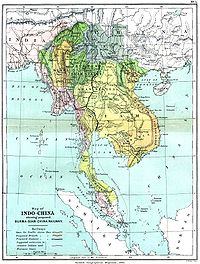North Vietnam: Difference between revisions
rm wikilinking - linking is made automcatically and non-linked text in this field allows categorisation |
→External links: Steven Spielberg? What was that doing there? |
||
| Line 85: | Line 85: | ||
==External links== |
==External links== |
||
*[http://www.mtholyoke.edu/acad/intrel/vietdec.htm Declaration of Independence of the Democratic Republic of Vietnam] |
*[http://www.mtholyoke.edu/acad/intrel/vietdec.htm Declaration of Independence of the Democratic Republic of Vietnam] |
||
[[Steven Spielberg]] |
|||
{{succession|office=Ruler of North Vietnam|years= 1945 - 1976 |preceded=[[Nguyễn Dynasty]]<br/>[[Empire of Vietnam|Empire of Việt Nam]]|succeeded=[[Socialist Republic of Vietnam|Socialist Republic of Việt Nam]]}} |
{{succession|office=Ruler of North Vietnam|years= 1945 - 1976 |preceded=[[Nguyễn Dynasty]]<br/>[[Empire of Vietnam|Empire of Việt Nam]]|succeeded=[[Socialist Republic of Vietnam|Socialist Republic of Việt Nam]]}} |
||
Revision as of 19:04, 29 April 2008
Democratic Republic of Vietnam Việt Nam Dân Chủ Cộng Hòa | |||||||||||
|---|---|---|---|---|---|---|---|---|---|---|---|
| 1945–1976 | |||||||||||
| Anthem: Tiến Quân Ca (Army March) | |||||||||||
 Location of North Vietnam | |||||||||||
| Capital | Hanoi | ||||||||||
| Common languages | Vietnamese | ||||||||||
| Government | Socialist republic | ||||||||||
| First president | |||||||||||
| Historical era | Cold War | ||||||||||
• Independence proclaimed (from Japan) | September 2 1945 | ||||||||||
• Recognized | 1954 | ||||||||||
• Disestablished | July 2 1976 | ||||||||||
| Area | |||||||||||
| 157,880 km2 (60,960 sq mi) | |||||||||||
| Currency | đồng | ||||||||||
| |||||||||||
¹As in Constitution of DRVN 1959 | |||||||||||
| History of Vietnam |
|---|
 |
|
|
The Democratic Republic of Vietnam (DRVN), or less commonly, Vietnamese Democratic Republic (Vietnamese: Việt Nam Dân Chủ Cộng Hòa), also known as North Vietnam, was proclaimed by Hồ Chí Minh in Hà Nội on September 2, 1945 with a declaration of independence, following the August Revolution, as a provisional government. It gathered Tonkin and Annam, provinces of the French Indochina.
Partition of Indochina
Following the partition of Vietnam in 1954, thousands of Vietnamese migrated to either the North and to the South. For example, an estimated 800,000 Catholics moved south. [1] The Catholic migration is attributed to perceived persecution of Catholics by the North Vietnamese government, as well as scare campaigns employed by the Saigon government of the Catholic Ngo Dinh Diem. [2] Concurrently, an estimated 130,000 people from South Việtnam who supported the Viet Minh headed for the North with the aid of Polish and Soviet ships.[3]
Between 1953 and 1956, the DRVN government instituted various agrarian reforms, including land redistribution. Large landowners were publicly denounced as landlords (địa chủ), and their land distributed to poor and middle peasants.
A literary movement called Nhân văn-Giai phẩm (from the names of the two magazines which started the movement) attempted to encourage the democratization of the country and the free expression of thought.
International relations
The Democratic Republic of Vietnam (North Vietnam) capital was Hà Nội and its government was led by the left-nationalist Vietnam Workers' Party, which had been formed in opposition to foreign (French and Japanese) involvement in the territory of Vietnam.
In December 1960, the Vietnam Workers' Party co-initiated and began working within the National Liberation Front of South Vietnam (referred to by the South as the Việt Cộng) which was organized to support reunification and oppose the government of South Vietnam. After August 1964, this was expanded to armed opposition to the military presence and operations of the United States in the southern areas of Vietnam.[4] From at least 1965 onwards, both China and the Soviet Union provided aid to North Vietnam in support of its military activities; known in the West as the Vietnam War and in Vietnam as the American War.
In June 1969, in the South, the NLF formed a Provisional Revolutionary Government in order to present an organized alternative government to the international community.[5]
In addition to the NLF, other nationalist insurgencies also operated within neighboring Laos and Cambodia, both formerly part of the French colonial territory of Indochina.
The Fall of Saigon

With the fall of Saigon to National Liberation Front and regular North Vietnamese armed forces on April 30, 1975, political authority within South Vietnam was assumed by the Provisional Revolutionary Government of the Republic of South Vietnam. This government merged with Democratic Republic of Vietnam on July 2, 1976, to form a single nation officially called the Socialist Republic of Vietnam (Cộng Hoà Xã Hội Chủ Nghĩa Việt Nam), or more commonly known as Việt Nam.
References
- ^ United Nations High Commission on Refugees. 2000. The State of the World's Refugees 2000: Fifty Years of Humanitarian Action. Oxford University Press. from.
- ^ Truong Nhu Tang. 1986. A Viet Cong Memoir. Vintage.
- ^ United Nations High Commission on Refugees. 2000. The State of the World's Refugees 2000: Fifty Years of Humanitarian Action. Oxford University Press. from.
- ^ Truong Nhu Tang. 1986. A Viet Cong Memoir. Vintage.
- ^ Truong Nhu Tang. 1986. A Viet Cong Memoir. Vintage.
See also
- August Revolution
- Vietnam
- Flag of North Vietnam
- South Vietnam
- Indochina Wars
- Hồ Chí Minh
- Socialist State
- People's Army of Vietnam
- Northern and southern Vietnam


